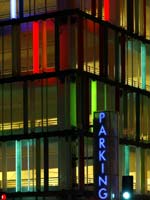By definition, isn't a "green" parking structure an oxymoron?

Photo: John Edward Linden. Santa Monica Civic Parking Structure: detail of multicolored channel-glass bays at Fourth Street and Civic Center Drive.
See A Civic Gateway: Santa Monica Civic Center Parking Structure: The humble parking garage is humble no more with a bold design that makes it a sparkling destination point in itself - oh, it's LEED green, too," from ArchNewsNow.
The last couple days, I've attended a couple presentations by the famed sociologist Richard Sennett, at the UMD. He is focusing on what he sees as the need for disruptive action to deal with the carbon offsets and global warming, with about a 60 year period to act.
One point he makes is that planning for coherence and order (opposed to the kind of organic complexity discussed by Jane Jacobs) produces what he calls "brittle cities," places unable to change very much or change very well in response to changed conditions.
In part, this is what Drew Ronneberg calls "planning for contraction," or others "Shrinking Cities." (Also see Youngstown 2010.)
The real disruption is that the U.S. population is based upon cheap energy. Cheap energy allows sprawl. It also allows for most of society to buy food that it doesn't produce. Similarly, water availability is key to sprawl and population growth. These resources are dwindling.
How can we possibly support the population we have, sprawling, in conditions of expensive energy, declining energy supplies, abundant energy supplies less conducive to vehicle use and massively carbon producing (coal), and declining water supplies?
That sets up real possibilities for disruption.
Labels: energy, environment, green construction



0 Comments:
Post a Comment
<< Home